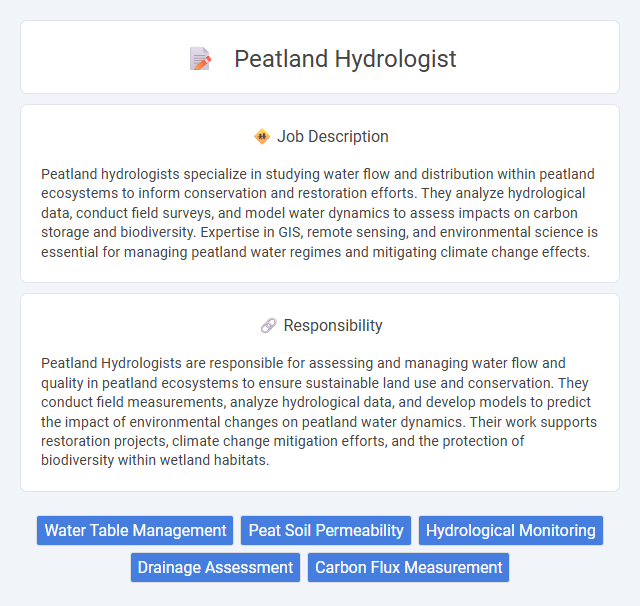
Peatland hydrologists specialize in studying water flow and distribution within peatland ecosystems to inform conservation and restoration efforts. They analyze hydrological data, conduct field surveys, and model water dynamics to assess impacts on carbon storage and biodiversity. Expertise in GIS, remote sensing, and environmental science is essential for managing peatland water regimes and mitigating climate change effects.
Individuals with a strong passion for environmental conservation and expertise in hydrology are likely to find the Peatland Hydrologist role highly suitable. Those comfortable with fieldwork, data analysis, and understanding wetland ecosystems may adapt well to the physical and technical demands of the job. Candidates who prefer routine indoor tasks or lack interest in ecosystem restoration might face challenges thriving in this position.
Qualification
A Peatland Hydrologist typically requires a bachelor's degree in hydrology, environmental science, geology, or a related field, with many positions favoring a master's degree for advanced research roles. Proficiency in hydrological modeling, GIS software, and data analysis tools is essential, alongside strong knowledge of peatland ecosystems and water management practices. Relevant experience in field data collection, wetland restoration, and environmental impact assessment significantly enhances job prospects.
Responsibility
Peatland Hydrologists are responsible for assessing and managing water flow and quality in peatland ecosystems to ensure sustainable land use and conservation. They conduct field measurements, analyze hydrological data, and develop models to predict the impact of environmental changes on peatland water dynamics. Their work supports restoration projects, climate change mitigation efforts, and the protection of biodiversity within wetland habitats.
Benefit
Peatland hydrologists are likely to benefit from contributing to critical ecosystem conservation and restoration efforts, which may enhance biodiversity and carbon sequestration. There is a probable chance of gaining specialized expertise in wetland hydrology and environmental impact assessment, potentially increasing their marketability in environmental consulting and research sectors. Job opportunities might also offer fieldwork diversity and collaboration with multidisciplinary teams, fostering professional growth and job satisfaction.
Challenge
Peatland Hydrologist roles likely involve the complexity of accurately modeling water flow in dynamic, water-saturated environments where seasonal changes and human activities impact hydrology. Challenges may arise from limited data availability and the necessity to balance ecosystem conservation with peatland restoration efforts. The job probably demands strong problem-solving skills to address uncertainties in hydrological predictions and implement sustainable management practices.
Career Advancement
Peatland hydrologists play a crucial role in managing and restoring wetland ecosystems to maintain carbon storage and biodiversity. Career advancement typically involves gaining expertise in water management, soil science, and environmental policy, enabling professionals to take on senior research or project management roles. Pursuing advanced degrees and certifications in hydrology or environmental science enhances opportunities for leadership positions within governmental agencies, environmental consulting firms, and conservation organizations.
Key Terms
Water Table Management
Peatland hydrologists specialize in water table management to maintain optimal moisture levels critical for peatland ecosystem health and carbon sequestration. They employ precise monitoring and modeling techniques to regulate water tables, preventing peat degradation and promoting sustainable land use. Effective water table management in peatlands supports biodiversity, reduces greenhouse gas emissions, and enhances soil stability.
Peat Soil Permeability
Peatland hydrologists specialize in assessing peat soil permeability to understand water flow and retention in wetland ecosystems. Accurate measurement of peat permeability is crucial for predicting hydrological responses and managing peatland restoration projects. Their expertise supports sustainable land use by mitigating drainage impacts and preserving carbon-rich peat soils.
Hydrological Monitoring
Hydrological monitoring in peatland hydrology involves measuring water table levels, soil moisture, and precipitation to assess the water balance within peat ecosystems. Precise data collection using piezometers, dataloggers, and remote sensing technologies ensures accurate evaluation of peatland hydrodynamics and carbon fluxes. This monitoring supports sustainable peatland management by informing restoration efforts and mitigating greenhouse gas emissions.
Drainage Assessment
Peatland hydrologists specializing in drainage assessment analyze water flow patterns and the impact of drainage systems on peatland ecosystems. They use advanced hydrological models and field measurements to evaluate how drainage affects carbon storage, wetland stability, and biodiversity. Their expertise guides sustainable management plans aimed at minimizing ecological disruption and maintaining peatland hydrological balance.
Carbon Flux Measurement
Peatland hydrologists specializing in carbon flux measurement analyze the exchange of carbon dioxide and methane between peatlands and the atmosphere to assess their role in climate regulation. They employ advanced techniques such as eddy covariance, chamber measurements, and remote sensing to quantify carbon fluxes accurately. This data supports modeling efforts to predict peatland responses to environmental changes and helps develop strategies for carbon management and conservation.
 kuljobs.com
kuljobs.com